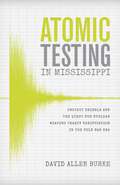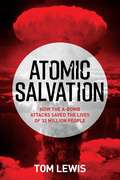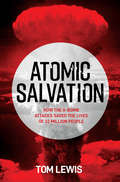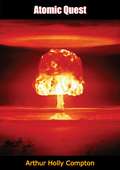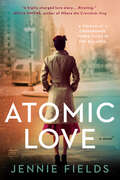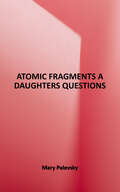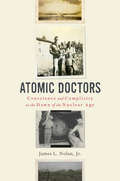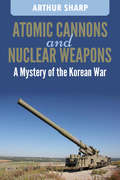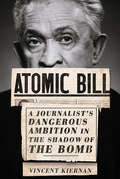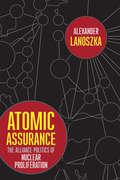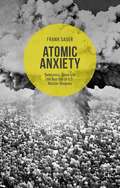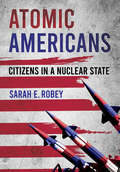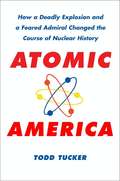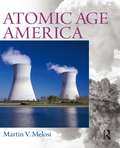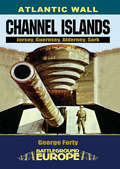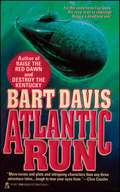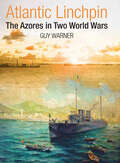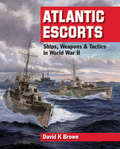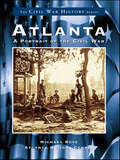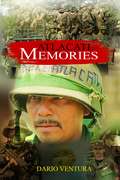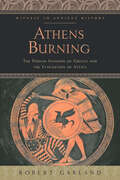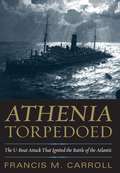- Table View
- List View
Atomic Testing in Mississippi: Project Dribble and the Quest for Nuclear Weapons Treaty Verification in the Cold War Era
by David Allen BurkeIn Atomic Testing in Mississippi, David Allen Burke illuminates the nearly forgotten history of America's only nuclear detonations east of the Mississippi River. The atomic tests, conducted in the mid-1960s nearly 3,000 feet below ground in Mississippi's Tatum Salt Dome, posed a potential risk for those living within 150 miles of the site, which included residents of Hattiesburg, Jackson, Gulfport, Biloxi, Mobile, and New Orleans. While the detonations provided the United States with verification methods that helped limit the world's nuclear arsenals, they sparked widespread public concern.In 1964 and 1966 the Atomic Energy Commission conducted experiments at the salt dome—code-named Dribble—surrounded by a greater population density than any other test site in the United States. Although the detonations were not weapons tests, they fostered a conflict between regional politicians interested in government-funded science projects and a population leery of nuclear testing near their homes. Even today, residents near the salt dome are still fearful of long-term negative health consequences.Despite its controversy, Project Dribble provided the technology needed to detect and assess the performance of distant underground atomic explosions and thus verify international weapons treaty compliance. This technology led to advanced seismological systems that now provide tsunami warnings and detect atomic activity in other nuclear nations, such as Pakistan and North Korea.
Atomic Salvation: How the A-Bomb attacks saved the lives of 32 million people
by Doctor Tom LewisSo did not the atomic weapons bring about a great peace? Since the initial grateful acknowledgement of the success of the A-bomb attacks in ending World War II, there has been a steady reversal of opinion and sentiment: from a first hearty appreciation to a condemnation by many, of the United States for its actions.Atomic Salvation investigates the full situation of the times to a previously unplumbed depth. It examines documents from both Japanese and Allied sources, but it uses logical in-depth analysis to extend beyond the mere recounting of statistics. It charts the full extent of the possible casualties on both sides if a conventional assault akin to D-Day had gone ahead. The work is concerned solely with the military necessity to use the bombs, but it also investigates why that necessity has been increasingly challenged over the successive decades. Controversially, the book shows that the Japanese nation would have lost many millions of their people – likely around 28 million – if the nation had been attacked in the manner by which Germany was defeated: by amphibious assault; artillery and air attacks preceding infantry insertion, and finally by subduing the last of the defenders of the enemy capital. From the other side, the book investigates the enormous political pressure placed on America as a result of their military situation. The USA&’s Truman Administration had little choice but to use the new weapon given the more than a million deaths Allied forces would undoubtedly have suffered through conventional assault. Through investigation of reactions then and since, Atomic Salvation charts reaction to the bombings. It looks briefly at a range of reactions through the decades and shows that there has been relentless pressure on the world to condemn what at the time was seen as the best, and the only, military solution to end the war. Never has such an exhaustive analysis been made of the necessity behind bringing World War II to a halt.
Atomic Salvation: How the A-Bomb Saved the Lives of 32 Million People
by Tom LewisA thought-provoking analysis of the bombing of Hiroshima and Nagasaki—and what might have happened if conventional weapons were used instead.It has always been a difficult concept to stomach—that the atomic bombs dropped on Hiroshima and Nagasaki in 1945, causing such horrific suffering and destruction, also brought about peace. Attitudes toward the event have changed through the years, from grateful relief that World War II was ended to widespread condemnation of the United States.Atomic Salvation investigates the full situation—examining documents from both Japanese and Allied sources, but also using in-depth analysis to extend beyond the mere recounting of statistics. It charts the full extent of the possible casualties on both sides had a conventional assault akin to D-Day gone ahead against Japan. The work is not concerned solely with the military necessity to use the bombs; it also investigates why that necessity has been increasingly challenged over the successive decades.Controversially, the book demonstrates that Japan would have suffered far greater casualties—likely around 28 million—if the nation had been attacked in the manner by which Germany was defeated: by amphibious assault, artillery and air attacks preceding infantry insertion, and finally by subduing the last of the defenders of the enemy capital. It also investigates the enormous political pressure placed on America as a result of their military situation. The Truman administration had little choice but to use the new weapon given the more than a million deaths that Allied forces would undoubtedly have suffered through conventional assault.By chartingreaction to the bombings over time, Atomic Salvation shows that there has been relentless pressure on the world to condemn what at the time was seen as the best, and only, military solution to end the conflict. Never has such an exhaustive analysis been made of the necessity behind bringing World War II to a halt.
Atomic Quest
by Arthur Holly ComptonDr. Compton’s book gives the reader an inside view of history in the making of the weapon that changed the world – the atomic bomb. As director of the Metallurgical Laboratory of the Manhattan Project he was a major participant in the research, production and testing of the bomb.From the vantage point of the key position he held from 1941 until 1945, Dr. Compton tells the whole story of the bomb’s progress from the presentation of the project to President Roosevelt, through its planning, research, and building phases, to its use in Japan. He depicts the project as a tremendous group effort enlisting the knowledge and talents of countless scientists, industrialists, and administrators, all of whom were working for the greater good of a nation in need of their help.“an absorbing and eminently readable account…It is packed with new information and enlivened with precious detail and illuminating insights into the minds and personalities of the chief actors in the drama.”—Henry Guerlac, The New York Times Book Review“Dr. Compton is a thinking man whose reflections range far beyond the confines of his scientific work: indeed, the distinctive quality of his book lies in his ability to reconcile the atomic bomb and similar operations with his belief as a practicing Christian.”—John Barkham, Saturday Review Syndicate“It should be required reading for every American, for the free world…The narrative alone makes the book worth reading; its hopeful philosophy makes it mandatory reading.”—Robert S. Kleckner, Chicago Sunday Tribune“For those who were in the project, it will mean many recollections. For those who were not, it should give an inkling of the character and capacity of many of the individuals, including Arthur Compton, who made success possible.”—Lieutenant General Leslie R. Groves, U.S. Army (Retired)
Atomic Love
by Jennie Fields"A novel of science, love, espionage, beautiful writing, and a heroine who carves a strong path in the world of men. As far as I'm concerned there is nothing left to want."--Ann Patchett, author The Dutch House"A highly-charged love story that reveals the dangerous energy at the heart of every real connection...Riveting."--Delia Owens, author of Where the Crawdads SingLove. Desire. Betrayal. Her choice could save a nation.Chicago, 1950. Rosalind Porter has always defied expectations--in her work as a physicist on the Manhattan Project and in her passionate love affair with colleague Thomas Weaver. Five years after the end of both, her guilt over the bomb and her heartbreak over Weaver are intertwined. She desperately misses her work in the lab, yet has almost resigned herself to a more conventional life.Then Weaver gets back in touch--and so does the FBI. Special Agent Charlie Szydlo wants Roz to spy on Weaver, whom the FBI suspects of passing nuclear secrets to Russia. Roz helped to develop these secrets and knows better than anyone the devastating power such knowledge holds. But can she spy on a man she still loves, despite her better instincts? At the same time, something about Charlie draws her in. He's a former prisoner of war haunted by his past, just as her past haunts her. As Rosalind's feelings for each man deepen, so too does the danger she finds herself in. She will have to choose: the man who taught her how to love . . . or the man her love might save?
Atomic Fragments: A Daughter's Questions
by Mary PalevskyMore than most of us, Mary Palevsky needed to come to terms with the moral complexities of the atomic bomb: Her parents worked on its development during World War II and were profoundly changed by that experience. After they died, unanswered questions sent their daughter on a search for understanding. <p><p>This compelling, sometimes heart-wrenching chronicle is the story of that quest. It takes her, and us, on a journey into the minds, memories, and emotions of the bomb builders. Scientists Hans Bethe, Edward Teller, Joseph Rotblat, Herbert York, Philip Morrison, Robert Wilson, and philosopher David Hawkins responded to Palevsky's personal approach in a way that dramatically expanded their previously published statements. Her skill and passion as an interlocutor prompt these men to recall their lives vividly and to reexamine their own decisions, debating within themselves the complex issues raised by the bomb. The author herself, seeking to comprehend the widely differing ways in which individual scientists made choices about the bomb and made sense of their work, deeply reconsiders those questions of commitment and conscience her parents faced. <p><p>In personal vignettes that complement the interviews, she captures other remembrances of the bomb through commemorative events and chance encounters with people who were "there." Her concluding chapter reframes the crucial moral questions in terms that show the questions themselves to be the abiding legacy we all share. This beautifully written book bridges generations to make its readers participants in the ongoing dialogue about science and philosophy, war and peace.
Atomic Doctors: Conscience And Complicity At The Dawn Of The Nuclear Age
by James L. NolanAn unflinching examination of the moral and professional dilemmas faced by physicians who took part in the Manhattan Project.After his father died, James L. Nolan, Jr., took possession of a box of private family materials. To his surprise, the small secret archive contained a treasure trove of information about his grandfather’s role as a doctor in the Manhattan Project. Dr. Nolan, it turned out, had been a significant figure. A talented ob-gyn radiologist, he cared for the scientists on the project, organized safety and evacuation plans for the Trinity test at Alamogordo, escorted the “Little Boy” bomb from Los Alamos to the Pacific Islands, and was one of the first Americans to enter the irradiated ruins of Hiroshima and Nagasaki.Participation on the project challenged Dr. Nolan’s instincts as a healer. He and his medical colleagues were often conflicted, torn between their duty and desire to win the war and their oaths to protect life. Atomic Doctors follows these physicians as they sought to maximize the health and safety of those exposed to nuclear radiation, all the while serving leaders determined to minimize delays and maintain secrecy. Called upon both to guard against the harmful effects of radiation and to downplay its hazards, doctors struggled with the ethics of ending the deadliest of all wars using the most lethal of all weapons. Their work became a very human drama of ideals, co-optation, and complicity.A vital and vivid account of a largely unknown chapter in atomic history, Atomic Doctors is a profound meditation on the moral dilemmas that ordinary people face in extraordinary times.
Atomic Cannons and Nuclear Weapons: A mystery of the Korean War
by Arthur G. SharpAn examination of the preparedness U.S. forces took to use nuclear warfare weaponry in the Korean War and an exmination of the usage of atomic cannons.
Atomic Bill: A Journalist's Dangerous Ambition in the Shadow of the Bomb
by Vincent KiernanIn Atomic Bill, Vincent Kiernan examines the fraught career of New York Times science journalist, William L. Laurence and shows his professional and personal lives to be a cautionary tale of dangerous proximity to power. Laurence was fascinated with atomic science and its militarization. When the Manhattan Project drew near to perfecting the atomic bomb, he was recruited to write much of the government's press materials that were distributed on the day that Hiroshima was obliterated. That instantly crowned Laurence as one of the leading journalistic experts on the atomic bomb. As the Cold War dawned, some assessed Laurence as a propagandist defending the militarization of atomic energy. For others, he was a skilled science communicator who provided the public with a deep understanding of the atomic bomb. Laurence leveraged his perch at the Times to engage in paid speechmaking, book writing, filmmaking, and radio broadcasting. His work for the Times declined in quality even as his relationships with people in power grew closer and more lucrative. Atomic Bill reveals extraordinary ethical lapses by Laurence such as a cheating scandal at Harvard University and plagiarizing from press releases about atomic bomb tests in the Pacific. In 1963 a conflict of interest related to the 1964 World's Fair in New York City led to his forced retirement from the Times. Kiernan shows Laurence to have set the trend, common among today's journalists of science and technology, to prioritize gee-whiz coverage of discoveries. That approach, in which Laurence served the interests of governmental official and scientists, recommends a full revision of our understanding of the dawn of the atomic era.
Atomic Assurance: The Alliance Politics of Nuclear Proliferation (Cornell Studies in Security Affairs)
by Alexander LanoszkaDo alliances curb efforts by states to develop nuclear weapons? Atomic Assurance looks at what makes alliances sufficiently credible to prevent nuclear proliferation; how alliances can break down and so encourage nuclear proliferation; and whether security guarantors like the United States can use alliance ties to end the nuclear efforts of their allies.Alexander Lanoszka finds that military alliances are less useful in preventing allies from acquiring nuclear weapons than conventional wisdom suggests. Through intensive case studies of West Germany, Japan, and South Korea, as well as a series of smaller cases on Great Britain, France, Norway, Australia, and Taiwan, Atomic Assurance shows that it is easier to prevent an ally from initiating a nuclear program than to stop an ally that has already started one; in-theater conventional forces are crucial in making American nuclear guarantees credible; the American coercion of allies who started, or were tempted to start, a nuclear weapons program has played less of a role in forestalling nuclear proliferation than analysts have assumed; and the economic or technological reliance of a security-dependent ally on the United States works better to reverse or to halt that ally’s nuclear bid than anything else.Crossing diplomatic history, international relations, foreign policy, grand strategy, and nuclear strategy, Lanoszka’s book reworks our understanding of the power and importance of alliances in stopping nuclear proliferation.
Atomic Anxiety: Deterrence, Taboo And The Non-use Of U. S. Nuclear Weapons
by Frank SauerWith the concept of 'Atomic Anxiety', this book offers a novel perspective on one of the most important and longstanding puzzles of international politics: the non-use of U.S. nuclear weapons. By focusing on the fear surrounding nuclear weapons, it explains why nuclear deterrence and the nuclear taboo are working at cross purposes in practice.
Atomic Americans: Citizens in a Nuclear State
by Sarah E. RobeyAt the dawn of the Atomic Age, Americans encountered troubling new questions brought about by the nuclear revolution: In a representative democracy, who is responsible for national public safety? How do citizens imagine themselves as members of the national collective when faced with the priority of individual survival? What do nuclear weapons mean for transparency and accountability in government? What role should scientific experts occupy within a democratic government? Nuclear weapons created a new arena for debating individual and collective rights. In turn, they threatened to destabilize the very basis of American citizenship.As Sarah E. Robey shows in Atomic Americans, people negotiated the contours of nuclear citizenship through overlapping public discussions about survival. Policymakers and citizens disagreed about the scale of civil defense programs and other public safety measures. As the public learned more about the dangers of nuclear fallout, critics articulated concerns about whether the federal government was operating in its citizens' best interests. By the early 1960s, a significant antinuclear movement had emerged, which ultimately contributed to the 1963 nuclear testing ban. Atomic Americans tells the story of a thoughtful body politic engaged in rewriting the rubric of rights and responsibilities that made up American citizenship in the Atomic Age.
Atomic America
by Todd TuckerOn January 3, 1961, nuclear reactor SL-1 exploded in rural Idaho, spreading radioactive contamination over thousands of acres and killing three men: John Byrnes, Richard McKinley, and Richard Legg. The Army blamed "human error" and a sordid love triangle. Though it has been overshadowed by the accident at Three Mile Island, SL-1 is the only fatal nuclear reactor incident in American history, and it holds serious lessons for a nation poised to embrace nuclear energy once again.Historian Todd Tucker, who first heard the rumors about the Idaho Falls explosion as a trainee in the Navy's nuclear program, suspected there was more to the accident than the rumors suggested. Poring over hundreds of pages of primary sources and interviewing the surviving players led him to a tale of shocking negligence and subterfuge.
Atomic Age America
by Martin V. MelosiAtomic Age America looks at the broad influence of atomic energy¿focusing particularly on nuclear weapons and nuclear power¿on the lives of Americans within a world context. The text examines the social, political, diplomatic, environmental, and technical impacts of atomic energy on the 20th and 21st centuries, with a look back to the origins of atomic theory.
Atlas of American Military History
by Stuart MurraySuitable for high school level and general readers, this book describes 28 significant military campaigns, both domestic and international, from the French and Indian War through the current war in Iraq. Arrangement is roughly chronological, beginning with on wars of the colonial period and of the young republic and continuing with the Civil War, emerging world power, World Wars I and II, hot wars of the Cold War, and activities of the lone superpower. Each chapter concludes with a section on instruments of war during the period under consideration. Annotation ©2004 Book News, Inc., Portland, OR (booknews.com)
Atlantic Wall: Jersey, Guernsey, Alderney, Sark (Battleground Europe)
by George FortyWhile the Germans did not succeed in invading Britain during World War II, they occupied a number of islands in the English Channel. The English population continued to lead fairly normal lives, while the German occupiers built some of the most extensive fortifications of the Second World War. As the war progressed, British commandos made occasional attacks, resulting in harsher conditions on the islands. The German garrisons were totally isolated by the D-Day landings, but managed to hold on through the following winter to surrender in May 1945. The author, a renowned military historian, examines these questions with complete candor, in addition to his study of the famous fortifications. All of the wartime events and the islands and their fortifications as they are today are covered in the popular Battleground Europe style, with illustrations, maps and then-and-now photographs.
Atlantic Run
by Bart DavisNavy Captain Peter MacKenzie must stop a renegade Russian captain from running the Northern Star, once the pride of the Soviet Union’s now extinct submarine fleet, to Cuba.
Atlantic Linchpin: The Azores in Two World Wars
by Guy WarnerOn a map the Azores appear as nine tiny specks in the middle of the Atlantic Ocean, but their location was to prove strategically vital in two world wars. The Atlantic became a crucial battleground twice within the space of 25 years, as the US ‘arsenal of democracy’ sent firstly stores, arms, and equipment, followed by many thousands of troops to fight in Europe. In both desperate and closely fought struggles at sea, Germany sought to stem the flow and thereby win the war by cutting this vital lifeline using a new weapon – the ocean-going submarine. In the First World War, the Azores became a mid-Atlantic refueling location, a base for US and Portuguese naval vessels and – in a hugely innovative contribution to the anti-submarine war – for the patrol seaplanes and flying boats of the US Marine Corps. Portugal was neutral during the Second World War but when Winston Churchill invoked a treaty dating from 1373, permission was given in 1943 for an RAF Coastal Command base to be very rapidly established at Lagens. From there convoys could be protected and U-boats could be harried and sunk, so closing the notorious mid-Atlantic gap. Later, it also became an important staging post for US aircraft, as it had been in the previous conflict. The significance of the Azores has been overlooked in most military histories, but this extensively researched and copiously illustrated book from historian Guy Warner provides a detailed but balanced appraisal. The author has had access to archives and photographic collections in the UK, USA, Portugal, and the Azores, consulting with local historians to produce a book that sheds much new light on a hitherto under-appreciated facet of twentieth-century history.
Atlantic Escorts: Ships, Weapons & Tactics in World War II
by David K. Brown&“Altogether, a very detailed year-by-year account of escort development for anti-submarine work from the period between the wars to post World War II.&” —The Nautical Magazine Winston Churchill famously claimed that the submarine war in the Atlantic was the only campaign of the Second World War that really frightened him. If the lifeline to North America had been cut, Britain would never have survived; there could have been no build-up of US and Commonwealth forces, no D-Day landings, and no victory in western Europe. Furthermore, the battle raged from the first day of the war until the final German surrender, making it the longest and arguably hardest-fought campaign of the whole war. The ships, technology and tactics employed by the Allies form the subject of this book. Beginning with the lessons apparently learned from the First World War, the author outlines inter-war developments in technology and training, and describes the later preparations for the second global conflict. When the war came the balance of advantage was to see-saw between U-boats and escorts, with new weapons and sensors introduced at a rapid rate. For the defending navies, the prime requirement was numbers, and the most pressing problem was to improve capability without sacrificing simplicity and speed of construction. The author analyses the resulting designs of sloops, frigates, corvettes and destroyer escorts and attempts to determine their relative effectiveness.&“Atlantic Escorts has flowed from the pen of a master who has written so many fine books about the history of ship construction. It is a small masterpiece.&” —Warship International Fleet Review
Atlanta: A Portrait of the Civil War (Civil War Series)
by Michael Rose Atlanta History CenterWhen the public envisions Atlanta during the Civil War, two primary images�of two unparalleled individuals�dominate: William Tecumseh Sherman and Scarlett O�Hara; however, there is more to the city�s Civil War heritage than a frowning general and a wily gentlewoman. Within the pages of Atlanta: A Portrait of the Civil War, discover the old city streets, period homes, and military fortifications of Atlanta in a number of rarely reproduced Civil War photographs. Taken from the Atlanta History Center�s visual arts collection, the images in this volume tell the story of the city as it was up to and during the Civil War. View the ruins of the Ponder House, the destruction of the rail lines, and the demolition of General Hood�s ordnance train. Informative captions complement this engaging collection of images, and include excerpts from diaries, letters, and memoirs regarding life in Atlanta during the war. Many of the photographs were taken by George N. Barnard and his staff during the Federal occupation of Atlanta in the fall of 1864, and again in 1866 as he planned a publication of war views. Atlanta: A Portrait of the Civil War offers a comprehensive view of the city during a war that continues to fascinate both professional and amateur historians alike.
Atlacatl Memories: There is not anything to translate. (There is not anything to translate. #1)
by Jeffrey Stuart IsfeldMEMORIES FROM ATLACATL by Dario Ventura FROM WAR TO PEACE A story told by ex-Salvadoran military personnel of their life and experiences during the Salvadoran civil war Memories of Atlacatl Testimonial book on one of the battalions of the Salvadoran civil war: BIRl Atlacatl, testimonial narratives of its former members Today I got up with the invitation to continue as a mute observer of today's veterans of the civil war, in silence so as not to cloud The story that they are determined to tell without being observed, the change of opinion of the military has surprised me; After more than 30 years of the civil war, everyone has made a decision not to tell their stories, but in an act of no less heroism than during the war they have decided to expose part of their experiences during the war. I have put myself behind the monitor to watch and listen to the film of their own lives, the countless hours remembering what was never contacted before by their own authors, their memories, the memories of Atlacatl.
Athletes Against War: Muhammad Ali, Bill Walton, Carlos Delgado, and More (Sports Illustrated Kids: Activist Athletes)
by Elliott SmithActivists take a stand. They speak out and demand change. From legendary boxer Muhammad Ali to baseball star Carlos Delgado, readers discover the pro athletes who have affected change by speaking out against war and its impact on society.
Athens Burning: The Persian Invasion of Greece and the Evacuation of Attica (Witness to Ancient History)
by Robert GarlandThe gripping story of how the Athenians survived the Persian invasion of their homeland—one of the central events in ancient Greek history.Winner of the CHOICE Outstanding Academic Title of the Choice ACRLBetween June 480 and August 479 BC, tens of thousands of Athenians evacuated, following King Xerxes’ victory at the Battle of Thermopylae. Abandoning their homes and ancestral tombs in the wake of the invading Persian army, they sought refuge abroad. Women and children were sent to one safe haven, the elderly to another, while all men of military age were conscripted into the fleet. During this difficult year of exile, the city of Athens was set on fire not once, but twice. In Athens Burning, Robert Garland explores the reasons behind the decision to abandon Attica, the peninsular region of Greece that includes Athens, while analyzing the consequences, both material and psychological, of the resulting invasion.Garland introduces readers to the contextual background of the Greco-Persian wars, which include the famous Battle of Marathon. He describes the various stages of the invasion from both the Persian and Greek point of view and explores the siege of the Acropolis, the defeat of the Persians first by the allied Greek navy and later by the army, and, finally, the return of the Athenians to their land.Taking its inspiration from the sufferings of civilians, Athens Burning also works to dispel the image of the Persians as ruthless barbarians. Addressing questions that are largely ignored in other accounts of the conflict, including how the evacuation was organized and what kind of facilities were available to the refugees along the way, Garland demonstrates the relevance of ancient history to the contemporary world. This compelling story is especially resonant in a time when the news is filled with the suffering of nearly 5 million people driven by civil war from their homes in Syria. Aimed at students and scholars of ancient history, this highly accessible book will also fascinate anyone interested in the burgeoning fields of refugee and diaspora studies.
Athens Burning: The Persian Invasion of Greece and the Evacuation of Attica (Witness to Ancient History)
by Robert Garland“A fresh approach to the Greco-Persian wars focusing on Athens’s evacuation, Persian occupation, and rebuilding . . . [a] compelling book.” —John O. Hyland, Christopher Newport UniversityWinner of the Choice Outstanding Academic TitleBetween June 480 and August 479 BC, tens of thousands of Athenians evacuated, following King Xerxes’ victory at the Battle of Thermopylae. Abandoning their homes and ancestral tombs in the wake of the invading Persian army, they sought refuge abroad. During this difficult year of exile, the city of Athens was set on fire not once, but twice. In Athens Burning, Robert Garland explores the reasons behind the decision to abandon Attica, the peninsular region of Greece that includes Athens, while analyzing the consequences, both material and psychological, of the resulting invasion.Taking its inspiration from the sufferings of civilians, Athens Burning also works to dispel the image of the Persians as ruthless barbarians. Addressing questions that are largely ignored in other accounts of the conflict, including how the evacuation was organized and what kind of facilities were available to the refugees along the way, Garland demonstrates the relevance of ancient history to the contemporary world. This compelling story is especially resonant in a time when the news is filled with the suffering of nearly 5 million people driven by civil war from their homes in Syria. Aimed at students and scholars of ancient history, this highly accessible book will also fascinate anyone interested in the burgeoning fields of refugee and diaspora studies.“The fullest account of the Persian sack of Athens in September 480 and in June 479 BCE available in English.” —Canadian Journal of History
Athenia Torpedoed
by Francis M. CarrollThis book is an account of a disaster at sea, the sinking by a German submarine of the passenger liner Athenia sailing from Liverpool to Montreal, loaded with Americans, Canadians, and Europeans, attempting to cross the Atlantic before the outbreak of war. Although 112 people were lost, of whom 30 were the first Americans killed in the war, 1,306 were rescued. Housewives, children, college students, scientists, actresses, and Jewish refugees were among the victims, and even young John F. Kennedy was called on to give assistance. The drama, tragedy, and triumph of their experiences are a central part of the story. But of course the book is also about war and politics. Indeed, this is actually where the Second World War began. Here Germany, having already invaded Poland in what was expected to be a limited war, first struck the western Allies, Britain and France. This was the first blow, fired without warning, just hours after war was declared. For Britain, the sinking of the Athenia was seen as both a violation of international law and a return to the kind of total war Germany had waged in the Great War. The sinking of the Athena immediately pushed Britain to adopt convoys to protect shipping, and it served from the first to shape British public opinion toward the war. In Canada the sinking of the ship and particularly the death of the innocent, ten year old Margaret Hayworth, became emotional issues around which much of the nation could rally in support of the decision of Parliament to go to war. In the United States President Franklin D. Roosevelt was too wary to make the sinking of the Athenia the counterpart of the sinking of the Lusitania in the First World War. However, the Athenia exposed Germany in the public mind as a serious threat to Americans, and provided the opportunity for President Roosevelt to open direct communication with Winston Churchill. The Athenia helped to change public opinion in the United States sufficiently to amend the existing Neutrality Laws to allow the country to sell munitions and supplies to Britain and France-a supportive first step to meeting the Nazi threat directly. So the sinking of the Athenia is a tale full of meaning and passion that deserves to be known.
